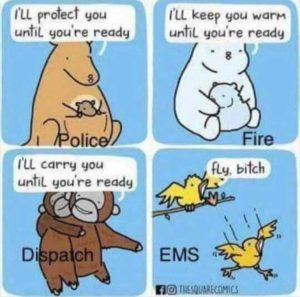Actual logistics. Let’s assume that we do decide to put in a degree requirement for paramedics. Let’s further assume that it’s going to be a four year degree. How many degree programs exist? Are there sufficient faculty with an “appropriate” terminal degree in the field to satisfy the higher education accreditation authorities? And on that note, what is an appropriate terminal degree for EMS? Would we now end up inadvertently or intentionally creating a doctorate in EMS education? Would current EMS educators be ineligible to continue what they’re already doing? The demand for nurses and nursing education has already created a shortage of nursing educators. What would EMS education do to meet that demand on day one?
What would happen with an actual EMS degree requirement? The skeptic and cynic in me says that most places wouldn’t have degree-educated paramedics. Instead, the “powers that be” will do one of two things. They will continue the current paramedic education and call it something else. Or they will water that down even further and create another “paramedic light” certification. See also: Rhode Island’s EMT-Cardiac, New York’s Advanced EMT-Critical Care, NREMT Intermediate-99 (thankfully being phased out), Virginia’s EMT-Intermediate, or Iowa’s “paramedic” based on the NREMT I-99 standard (the actual “full” paramedic in Iowa was called a “paramedic specialist). And I will make you a bet that the majority of large EMS operations in this country will immediately default to providing service at this “paramedic light” level.
If we want degree educated paramedics and believe that’s for the best, we’re going to need to answer these questions. And we’re also going to need find the funding for this. That probably means getting the primary payer of EMS services, the Federal government, to change Medicare/Medicaid so that EMS systems are paid for treatment and services rendered rather than just transport mileage. But to do that means that we’re going to have to be more involved in the political process rather than the occasional appearance on a designated “lobby your politician” day where you wear a uniform that looks something like a third world dictator. The truth be told, increased EMS education and increased EMS reimbursement are like the chicken and the egg. I don’t know which comes first.
I’d also point out something said by a former EMS director of mine. He said he’s paying paramedics (and EMTs) what he can afford to pay them, not what he wants to pay them. Again, until reimbursement changes, there’s no magic source of increased paramedic compensation, even with higher education.
Before you think I oppose an EMS degree, let me say that I don’t. I believe that a four year degree is appropriate for a medical professional. I also don’t know that all of the advocates of an EMS degree have fully thought out the impact of such a requirement, even if gradually phased in.
I believe that our current America EMS system may be like Churchill’s definition of democracy. Churchill said that “Indeed it has been said that democracy is the worst form of Government except for all those other forms that have been tried from time to time.…” I believe that we may find this to be equally true for American EMS if we suddenly change our educational paradigm without considering the consequences.
These concerns and this rant was brought to you by a mostly proud graduate of a certificate granting paramedic program who also had a bachelor’s degree in liberal arts followed by a graduate and a professional degree. Higher education taught me to think. Paramedic education taught me to do. And coming into a paramedic program with a college degree taught me to think and consider what I do as a paramedic.
